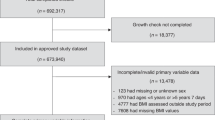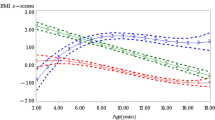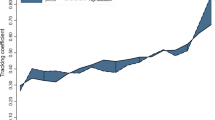Abstract
Background/objectives
Childhood obesity is a serious public health challenge. Cross-sectional evidence indicates that childhood obesity is strongly linked to area deprivation level, yet longitudinal research is scarce. We assessed the association of home-based and school-based deprivation indices with change in childhood body-mass index (BMI) z-score and BMI status over 6 years in Hampshire, England.
Subjects/Methods
This longitudinal study linked the National Child Measurement Programme data for children aged 4–5 years (2007–08 to 2009–10) to 10–11 years. The dataset was stratified into two groups: 18,733 children for whom home deprivation quintiles, according to the Index of Multiple Deprivation (IMD), remained constant, and 6153 children who moved home deprivation quintiles between the two time points. The associations between IMD quintiles and change in BMI z-score and status were analysed.
Results
63.7% of children remained a healthy weight, 3.1% remained overweight, 5.3% remained with obesity, 8.3% became overweight, and 10.3% developed obesity. Children living in the most deprived quintile increased their BMI z-score by 0.13 units more than those in the least deprived quintile (95% CI: 0.08–0.19). Home-based deprivation displayed associations with change in BMI status. (Relative risk for the most deprived quintile: become overweight 1.47, 1.21–1.78, remain obese 1.82, 1.34–2.40, become obese 2.07, 1.73–2.48.) School-based deprivation was not associated with change in BMI z-score or BMI status. Moving home to a more deprived quintile was associated with developing obesity (1.22, 1.04–1.43).
Conclusions
More children living in deprived areas developed obesity over time. Home-based deprivation level is more strongly associated with adverse change in childhood weight than school-based deprivation. Scholarly settings can provide opportunities for interventions, however obesity prevention interventions should tackle the obesogenic environment combining family and area-based measures.
This is a preview of subscription content, access via your institution
Access options
Subscribe to this journal
Receive 12 print issues and online access
$259.00 per year
only $21.58 per issue
Buy this article
- Purchase on Springer Link
- Instant access to full article PDF
Prices may be subject to local taxes which are calculated during checkout

Similar content being viewed by others
References
Public Health England. Childhood obesity: overview. 2016. http://www.noo.org.uk/NOO_about_obesity/child_obesity. Accessed 17 Sept 2016.
The World Health Organisation. Obesity and overweight. 2016. http://www.who.int/mediacentre/factsheets/fs311/en/. Accessed 17 Sept 2016.
The World Health Organisation. Why does childhood overweight and obesity matter? 2016. http://www.who.int/dietphysicalactivity/childhood_consequences/en/. Accessed 17 Sept 2016.
Centers for Disease Control and Prevention. The health effects of overweight and obesity. 2015. http://www.cdc.gov/healthyweight/effects/. Accessed 12 Sept 2016.
Public Health England. Health risks of childhood obesity. 2016. https://www.noo.org.uk/NOO_about_obesity/obesity_and_health/health_risk_child. Accessed 17 Jan 2017.
Wardle J, Cooke L. The impact of obesity on psychological well-being. Best Pract Res Clin Endocrinol Metab. 2005;19:421–40.
European Association for the Study of Obesity. Obesity facts and figures. 2015. http://easo.org/education-portal/obesity-facts-figures/. Accessed 26 Jun 2016.
NHS Digital. National child measurement programme—England, 2015–16: Tables. 2016. http://content.digital.nhs.uk/searchcatalogue?productid=23381&q=national+child+measurement+programme&sort=Relevance&size=10&page=1#top. Accessed 15 Dec 2016.
Government Office for Science. Foresight. Tackling obesities: future choices—report. 2nd ed. 2007 https://www.gov.uk/government/uploads/system/uploads/attachment_data/file/287937/07-1184×-tackling-obesities-future-choices-report.pdf. Accessed 12 Dec 2016.
Public Health England. Health matters: obesity and the food environment. 2017. https://www.gov.uk/government/publications/health-matters-obesity-and-the-food-environment/health-matters-obesity-and-the-food-environment-2. Accessed 31 Mar 2017.
Whitehead M. The health divide. In: Townsend P, Davidson N, Whitehead W, editors. Inequalities in health. 1992 edition. Middlesex, England: Penguin books; 1992. p. 236.
Ministry of Housing, Communities and Local Government. English indices of deprivation. 2015. https://www.gov.uk/government/statistics/english-indices-of-deprivation-2015. Accessed 19 Nov 2016
National Obesity Observatory. Child obesity and socioeconomic status. http://www.noo.org.uk/uploads/doc/vid_16967_ChildSocioeconSep2012.pdf. Accessed 18 Aug 2016.
Bammann K, Gwozdz W, Pischke C, Eiben G, Fernandez-Alvira JM, Henauw SDe, et al. The impact of familial, behavioural and psychosocial factors on the SES gradient for childhood overweight in Europe. A longitudinal study. Int J Obes. 2017;41:54–60.
Carter MA, Dubois L, Tremblay MS, Taljaard M. The influence of place on weight gain during early childhood: a population-based, longitudinal study. J Urban Health. 2013;90:224–39.
Wheaton N, Millar L, Allender S, Nichols M. The stability of weight status through the early to middle childhood years in Australia: a longitudinal study. BMJ Open. 2015:5. https://doi.org/10.1136/bmjopen-2014-006963.
Jansen PW, Mensah FK, Nicholson JM, Wake M. Family and neighbourhood socioeconomic inequalities in childhood trajectories of BMI and overweight: longitudinal study of Australian children. PLoS ONE. 2013:8. https://doi.org/10.1371/annotation/f7e5e1f3-77f6-4c56-b0ba-53b54a86df14.
Gose M, Plachta-Danielzik S, Willie B, Johannsen M, Landsberg B, Muller MJ. Longitudinal influences of neighbourhood built and social environment on children’s weight status. Int J Environ Res Public Health. 2013;10:5083–96.
Norman P, Boyle P, Rees P. Selective migration, health and deprivation: a longitudinal analysis. Soc Sci Med. 2005;12:2755–71.
Heritage T, Mcmanus J. Hertfordshire’s public health strategy. In: Hertfordshire assembly meeting. Hertfordshire County Council. Hertfordshire, 2013.
NHS Digital. National child measurement programme. 2016. http://content.digital.nhs.uk/NCMP. Accessed 17 June 2016.
Public Health England. National child measurement programme operational guidance. 2016. https://www.gov.uk/government/uploads/system/uploads/attachment_data/file/531878/NCMP-OperationalGuidance.pdf. Accessed 15 June 2016.
Inokuchi M, Matsuo N, Takayama JI, Hasegawa T. BMI z-score is the optimal measure of annual adiposity change in elementary school children. Ann Hum Biol. 2011;38:747–51.
Cole TJ, Faith MS, Pietrobelli A, Heo M. What is the best measure of adiposity change in growing children: BMI, BMI %, BMI z-score or BMI centile? Eur J Clin Nutr. 2005;59:419–25.
Must A, Anderson SE. Body mass index in children and adolescents: considerations for population-based application. Int J Obes. 2006;30:590–94.
National Obesity Observatory. A simple guide to classifying body mass index in children. 2011. https://khub.net/documents/31798783/32039025/A+simple+guide+to+classifying+body+mass+index+in+children/ced23256-6f8d-43c7-9f44-222ea2beebf97?version=1.0. Accessed 10 Dec 2016.
Department for Communities and Local Government. The English indices of deprivation: technical report. 2015. https://www.gov.uk/government/uploads/system/uploads/attachment_data/file/464485/English_Indices_of_Deprivation_2015_-_Technical-Report.pdf. Accessed 18 July 2016.
Little E. Association of deprivation with overweight and obesity among primary school children in England: an ecological cross-sectional study. The Lancet. 2017:390. S59
Ministry of Housing, Communities and Local Government. English Indices of Deprivation 2015 area look up. 2015. http://imd-by-geo.opendatacommunities.org/area. Accessed 19 Nov 2016.
Department for Communities and Local Government. The English Indices of Deprivation: Technical Report. 2015. https://www.gov.uk/government/uploads/system/uploads/attachment_data/file/464485/English_Indices_of_Deprivation_2015_-_Technical-Report.pdf
Moore DB, Howell PB, Treiber FA. Changes in overweight in youth over a period of 7 years: impact of ethnicity, gender and socioeconomic status. Ethnic Dis. 2002;12:83–6.
Ofsted. School inspection handbook. Ofsted. Report number 150066; 2016.
Ofsted. State funded schools statistics. 2014. https://www.gov.uk/government/collections/maintained-schools-and-academies-inspections-and-outcomes-official-statistics. Accessed Nov 2016.
Office for National Statistics. Rural urban classification (2011) of lower layer super output areas in England and Wales. 2013. http://ons.maps.arcgis.com/home/item.html?id=9855221596994bde8363a685cb3dd58a. Accessed 12 Oct 2016.
Stata. Stata for Windows. 2016. https://www.stata.com/products/windows/. Accessed 21 Nov 2016.
NHS Digital. Data quality statement. 2015. https://files.digital.nhs.uk/publicationimport/pub19xxx/pub19109/nati-chil-meas-prog-eng-2014-2015-qual.pdf. Accessed 6 Dec 2016.
Semmler C, Ashcroft J, Van Jaarsveld CHM, Carnell S, Wardle J. Development of overweight in children in relation to parental weight and socioeconomic status. Obesity. 2009;17:814–20.
Oliver LN, Hayes MV. Effects of neighbourhood income on reported body mass index: an eight year longitudinal study of Canadian Children. BMC Public Health. 2008;8. 16
Valerio G, D'Amico O, Adinolfi M, Munciguerra A, D'Amico R, Franzese A. Determinants of weight gain in children from 7 to 10 years. Nutr Metab Cardiovasc Dis. 2006;16:272–8.
O’Dea JA, Chiang H, Peralta LR. Socioeconomic patterns of overweight, obesity but not thinness persist from childhood to adolescence in a 6-year longitudinal cohort of Australian school children from 2007 to 2012. BMC Public Health. 2014;14:222 https://doi.org/10.1186/1471-2458-14-222. Accessed 17 June 2016.
Kinra S, Nelder RP, Lewendon GJ. Deprivation and childhood obesity: a cross sectional study of 20 973 children in Plymouth, United Kingdom. J Epidemiol Community Health. 2000;54:456–60.
Parkes A, Sweeting H, Young, R, Wight D. Does parenting help to explain socioeconomic inequalities in children’s body mass index trajectories? Longitudinal analysis using the Growing Up in Scotland study. J Epidemiol Community Health. 2016;70. 868–73
O’Dea JA, Dibley MJ, Rankin NM. Low sleep and low socioeconomic status predict high body mass index: a 4year longitudinal study of Australian school children. Pediatr Obes. 2012;4:295–303.
Norman P, Rees P, Boyle P. Achieving data compatibility over space and time: creating consistent geographical zones. Popul Space Place. 2003;9:365–86.
Acknowledgements
We would like to acknowledge Hampshire County Council’s Director of Public Health for facilitating the use of the data in this research and the University of Southampton M.Sc. Public Health Team for their support. This research was conducted as an M.Sc. Public Health dissertation project. AT was supported by Health Education England-Wessex to complete the M.Sc. Programme.
Author information
Authors and Affiliations
Corresponding author
Ethics declarations
Conflict of interest
The authors declare that they have no conflict of interest.
Additional information
Publisher’s note: Springer Nature remains neutral with regard to jurisdictional claims in published maps and institutional affiliations.
Rights and permissions
About this article
Cite this article
Twaits, A., Alwan, N.A. The association between area-based deprivation and change in body-mass index over time in primary school children: a population-based cohort study in Hampshire, UK. Int J Obes 44, 628–636 (2020). https://doi.org/10.1038/s41366-019-0418-9
Received:
Revised:
Accepted:
Published:
Issue Date:
DOI: https://doi.org/10.1038/s41366-019-0418-9
This article is cited by
-
Difference in the prevalence of hypertension and its risk factors depending on area-level deprivation in Japan
BMC Research Notes (2022)
-
A profile of children’s physical activity data from the 2012 and 2015 health survey for England
BMC Public Health (2022)
-
Neighborhood deprivation index is associated with weight status among long-term survivors of childhood acute lymphoblastic leukemia
Journal of Cancer Survivorship (2021)
-
Are environmental area characteristics at birth associated with overweight and obesity in school-aged children? Findings from the SLOPE (Studying Lifecourse Obesity PrEdictors) population-based cohort in the south of England
BMC Medicine (2020)
-
Defining critical factors in multi-country studies of assisted reproductive technologies (ART): data from the US and UK health systems
Journal of Assisted Reproduction and Genetics (2020)



